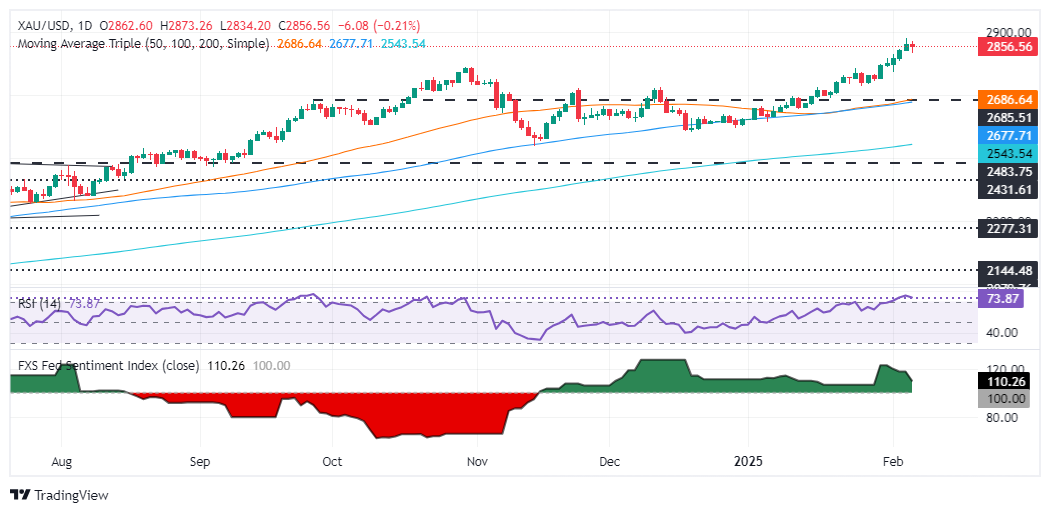- Gold drops amid rising US Treasury yields and a stronger US Dollar.
- US equity downturn and job market worries heighten market jitters ahead of Nonfarm Payrolls.
- Fed’s Goolsbee suggests cautious monetary policy, impacting gold amidst global trade tensions.
Gold price advance stalled on Thursday as United States (US) Treasury bond yields recovered, and the Greenback holds minimal gains. Traders seem to be booking profits ahead of the release of the latest US Nonfarm Payrolls report, which could spark volatility in the financial markets. XAU/USD traded at $2,852, down 0.38%.
With no clear catalyst, the market mood shifted negatively as US equity indices turned lower. Despite this, the non-yielding metal continued to trim some of its weekly gains amid increased tensions due to the trade war between China and the US.
In addition, US jobs data showed that the number of people applying for unemployment benefits rose in the week ending February 1, revealed the US Department of Labor. A Bloomberg report said the report was mainly ignored due to distortions spurred by wildfires in Los Angeles and worse weather conditions in other parts of the US.
Bullion failed to gain traction amid dovish comments by Chicago Fed President Austan Goolsbee. He said the Fed is in good shape for eventual cuts, though he added that uncertainty around Washington policies warrants a “slower approach.”
Daily digest market movers: Gold price weighed by US yields recovery
- The US Dollar Index (DXY), which tracks the buck’s performance versus a basket of six currencies, holds minimal gains of 0.06% and is at 107.68.
- The US 10-year Treasury bond yield climbs one and a half basis points, up at 4.44%.
- US real yields, which correlate inversely to Bullion prices, climb one and a half basis points from 2.01% to 2.0026%, a tailwind for XAU/USD.
- For the week ending February 1, US Initial Jobless Claims increased to 219K, up from 208K the previous week and surpassing forecasts of 213K. This rise indicates more Americans filed for unemployment benefits than expected.
- US Nonfarm Payrolls in January are expected to dip from 256K to 170K. The Unemployment Rate is projected to remain unchanged at 4.1%.
- Money market fed funds rate futures are pricing in 47.5 basis points (bps) of easing by the Federal Reserve in 2025.
XAU/USD technical outlook: Gold price falls below $2,860
Despite dipping, the XAU/USD pair is poised to extend its rally and challenge the year-to-date (YTD) high of $2,882 ahead of $2,890. Once those two levels are cleared, the next resistance would be $2,900.
The Relative Strength Index (RSI) remains at overbought territory. Still, as previously mentioned, “it hasn’t reached the most extreme level above 80, which could pave the way for a mean-reversion trade.”
Therefore, XAU/USD fell to a daily low of $2,834, but buyers lifted Gold prices above $2,850, opening the door for further upside.
Conversely, if Bullion plunges below $2,800, immediate support would be the January 27 swing low of $2,730, followed by $2,700.

Nonfarm Payrolls FAQs
Nonfarm Payrolls (NFP) are part of the US Bureau of Labor Statistics monthly jobs report. The Nonfarm Payrolls component specifically measures the change in the number of people employed in the US during the previous month, excluding the farming industry.
The Nonfarm Payrolls figure can influence the decisions of the Federal Reserve by providing a measure of how successfully the Fed is meeting its mandate of fostering full employment and 2% inflation. A relatively high NFP figure means more people are in employment, earning more money and therefore probably spending more. A relatively low Nonfarm Payrolls’ result, on the either hand, could mean people are struggling to find work. The Fed will typically raise interest rates to combat high inflation triggered by low unemployment, and lower them to stimulate a stagnant labor market.
Nonfarm Payrolls generally have a positive correlation with the US Dollar. This means when payrolls’ figures come out higher-than-expected the USD tends to rally and vice versa when they are lower. NFPs influence the US Dollar by virtue of their impact on inflation, monetary policy expectations and interest rates. A higher NFP usually means the Federal Reserve will be more tight in its monetary policy, supporting the USD.
Nonfarm Payrolls are generally negatively-correlated with the price of Gold. This means a higher-than-expected payrolls’ figure will have a depressing effect on the Gold price and vice versa. Higher NFP generally has a positive effect on the value of the USD, and like most major commodities Gold is priced in US Dollars. If the USD gains in value, therefore, it requires less Dollars to buy an ounce of Gold. Also, higher interest rates (typically helped higher NFPs) also lessen the attractiveness of Gold as an investment compared to staying in cash, where the money will at least earn interest.
Nonfarm Payrolls is only one component within a bigger jobs report and it can be overshadowed by the other components. At times, when NFP come out higher-than-forecast, but the Average Weekly Earnings is lower than expected, the market has ignored the potentially inflationary effect of the headline result and interpreted the fall in earnings as deflationary. The Participation Rate and the Average Weekly Hours components can also influence the market reaction, but only in seldom events like the “Great Resignation” or the Global Financial Crisis.
Financial Market Newsflash
No financial news published today. Check back later.










